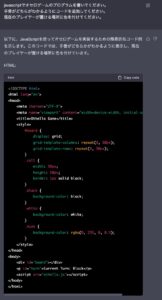話題になっているGPT-4を使ってオセロゲームを作ってみました。
実際に出来たゲームは次のものになります。
GPT-4を使うことで、このように簡単なコードならこれまでよりも圧倒的に少ない工数で実現できるようになりました。
GPT-4の説明とともに、今回GPT-4が作成してくれたコードを紹介していきたいと思います。
ChatGPT(GPT-4)とは何か?
GPT-4は、OpenAIが開発した最新のAI言語モデルで、自然言語処理(NLP)タスクに優れた性能を発揮します。GPT-4は、大規模なデータセットを元にトレーニングされ、多数の言語をサポートしています。
前世代のGPT-3をさらに進化させたモデルで、Transformerアーキテクチャをベースにしています。このアーキテクチャは、自己注意メカニズムを利用して、文の内部構造を捉える能力が高いため、NLPタスクで高い精度を実現しています。
ChatGPT(GPT-4)を活用したオセロゲームの作成
GPT-4を活用してオセロゲームを作りました。
javascriptでオセロゲームのプログラムを書いてください。
手番がどちらがわかるようにコードを追加してください。
現在のプレイヤーが置ける場所に色を付けてください。
この一文で簡単なオセロゲームを作ってくれます。
さらにオセロゲームに条件を追加したい場合は出来たコードをインプットさせつつ、条件を追加すれば既存のコードに追加する形でブラッシュアップされたコードを提案してくれます。
以下は例ですが、このような感じでコードを提供してくれます。

簡単ですね。
オセロゲームのコード
最終的に出来たオセロゲームのコードは次のようになりました。
ChatGPTで出来たコードを何度かインプットしながら条件を付け足して修正と追加を繰り返しています。
<!DOCTYPE html>
<html lang="ja">
<head>
<meta charset="UTF-8">
<meta name="viewport" content="width=device-width, initial-scale=1.0">
<title>オセロゲーム</title>
<style>
body {
display: flex;
flex-direction: column;
justify-content: center;
align-items: center;
height: 100vh;
background-color: #F0F0F0;
margin: 0;
}
#game-board {
box-shadow: 0px 0px 10px rgba(0, 0, 0, 0.5);
padding: 20px;
background-color: #FFFFFF;
}
canvas {
display: block;
margin: 0 auto;
border: 1px solid black;
}
#current-player {
margin-top: 10px;
font-size: 18px;
font-weight: bold;
}
</style>
</head>
<body>
<div id="game-board">
<canvas id="board" width="400" height="400"></canvas>
<p id="current-player">現在の手番: 黒</p>
</div>
<button id="reset-button">ゲームをリセット</button>
<script>
const canvas = document.getElementById('board');
const ctx = canvas.getContext('2d');
const tileSize = 50;
const boardSize = 8;
const board = new Array(boardSize).fill(null).map(() => new Array(boardSize).fill(null));
const currentPlayerElement = document.getElementById('current-player');
let currentPlayer = 'black';
initializeBoard();
function initializeBoard() {
// Add this loop to reset the board array
for (let row = 0; row < boardSize; row++) {
for (let col = 0; col < boardSize; col++) {
board[row][col] = null;
}
}
board[3][3] = 'white';
board[4][4] = 'white';
board[3][4] = 'black';
board[4][3] = 'black';
drawBoard();
}
function isValidMove(row, col, player) {
if (board[row][col]) return false;
const directions = [
[-1, 0], [1, 0], [0, -1], [0, 1],
[-1, -1], [1, 1], [-1, 1], [1, -1]
];
for (const [dx, dy] of directions) {
let newRow = row + dx;
let newCol = col + dy;
let flipped = false;
while (newRow >= 0 && newRow < boardSize && newCol >= 0 && newCol < boardSize && board[newRow][newCol] === (player === 'black' ? 'white' : 'black')) {
newRow += dx;
newCol += dy;
flipped = true;
}
if (flipped && newRow >= 0 && newRow < boardSize && newCol >= 0 && newCol < boardSize && board[newRow][newCol] === player) {
return true;
}
}
return false;
}
function placePiece(row, col, player) {
if (!isValidMove(row, col, player)) return false;
board[row][col] = player;
const directions = [
[-1, 0], [1, 0], [0, -1], [0, 1],
[-1, -1], [1, 1], [-1, 1], [1, -1]
];
for (const [dx, dy] of directions) {
let newRow = row + dx;
let newCol = col + dy;
let flipped = false;
while (newRow >= 0 && newRow < boardSize && newCol >= 0 && newCol < boardSize && board[newRow][newCol] === (player === 'black' ? 'white' : 'black')) {
newRow += dx;
newCol += dy;
flipped = true;
}
if (flipped && newRow >= 0 && newRow < boardSize && newCol >= 0 && newCol < boardSize && board[newRow][newCol] === player) {
newRow -= dx;
newCol -= dy;
while (newRow !== row || newCol !== col) {
board[newRow][newCol] = player;
newRow -= dx;
newCol -= dy;
}
}
}
return true;
}
function hasValidMove(player) {
for (let row = 0; row < boardSize; row++) {
for (let col = 0; col < boardSize; col++) {
if (isValidMove(row, col, player)) return true;
}
}
return false;
}
function countPieces() {
let blackCount = 0;
let whiteCount = 0;
for (let row = 0; row < boardSize; row++) {
for (let col = 0; col < boardSize; col++) {
if (board[row][col] === 'black') {
blackCount++;
} else if (board[row][col] === 'white') {
whiteCount++;
}
}
}
return { black: blackCount, white: whiteCount };
}
function switchPlayer() {
currentPlayer = currentPlayer === 'black' ? 'white' : 'black';
currentPlayerElement.textContent = `現在の手番: ${currentPlayer === 'black' ? '黒' : '白'}`;
if (!hasValidMove(currentPlayer)) {
currentPlayer = currentPlayer === 'black' ? 'white' : 'black';
currentPlayerElement.textContent = `現在の手番: ${currentPlayer === 'black' ? '黒' : '白'}`;
if (!hasValidMove(currentPlayer)) {
const { black, white } = countPieces();
alert(`ゲーム終了!黒: ${black} - 白: ${white}`);
}
}
}
function drawBoard() {
ctx.fillStyle = '#228B22';
ctx.fillRect(0, 0, canvas.width, canvas.height);
// Draw grid lines
ctx.strokeStyle = '#000000';
for (let i = 1; i < boardSize; i++) {
ctx.beginPath();
ctx.moveTo(i * tileSize, 0);
ctx.lineTo(i * tileSize, canvas.height);
ctx.stroke();
ctx.beginPath();
ctx.moveTo(0, i * tileSize);
ctx.lineTo(canvas.width, i * tileSize);
ctx.stroke();
}
for (let row = 0; row < boardSize; row++) {
for (let col = 0; col < boardSize; col++) {
if (board[row][col]) {
ctx.fillStyle = board[row][col] === 'black' ? '#000000' : '#FFFFFF';
ctx.beginPath();
ctx.arc(col * tileSize + tileSize / 2, row * tileSize + tileSize / 2, tileSize / 2 - 5, 0, Math.PI * 2);
ctx.fill();
} else if (isValidMove(row, col, currentPlayer)) {
ctx.fillStyle = currentPlayer === 'black' ? 'rgba(0, 0, 0, 0.5)' : 'rgba(255, 255, 255, 0.5)';
ctx.beginPath();
ctx.arc(col * tileSize + tileSize / 2, row * tileSize + tileSize / 2, tileSize / 2 - 5, 0, Math.PI * 2);
ctx.fill();
} else if (isValidMove(row, col, currentPlayer === 'black' ? 'white' : 'black')) {
ctx.fillStyle = currentPlayer === 'black' ? 'rgba(255, 255, 255, 0.5)' : 'rgba(0, 0, 0, 0.5)';
ctx.beginPath();
ctx.arc(col * tileSize + tileSize / 2, row * tileSize + tileSize / 2, tileSize / 2 - 5, 0, Math.PI * 2);
ctx.fill();
}
}
}
}
document.getElementById('reset-button').addEventListener('click', () => {
initializeBoard();
currentPlayer = 'black';
currentPlayerElement.textContent = `現在の手番: 黒`;
});
canvas.addEventListener('click', (e) => {
const col = Math.floor(e.offsetX / tileSize);
const row = Math.floor(e.offsetY / tileSize);
if (placePiece(row, col, currentPlayer)) {
drawBoard();
switchPlayer();
}
});
drawBoard();
</script>
</body>
</html>ChatGPT(GPT-4)の将来性
簡単なゲームやプログラムコードならChatGPTを使ってすぐに作ることができるようになりました。
今後は新しいプロダクトやゲームの案などを市場で検証する場合は、ChatGPTで実装してまず検証を行うなど出来そうですね。
また今まで実装までに長い時間がかかっていたコードなどもすぐに作れるようになるので、多くの手間と工数がかかっていたプロダクト開発をより安価で少ない工数で実現できるようになるのではないかと思います。
今後はGPT-4のAPIを使ったプロダクト開発も多く出てくることでしょう。
まとめ
仕事が奪われるのではないかと心配しているエンジニアも多くいますが、今後のGPT-4の発展には期待しかありません。
AIをうまく使いこなしながら効果的なValueをユーザーに提供できるように頑張りたいものです。



コメント